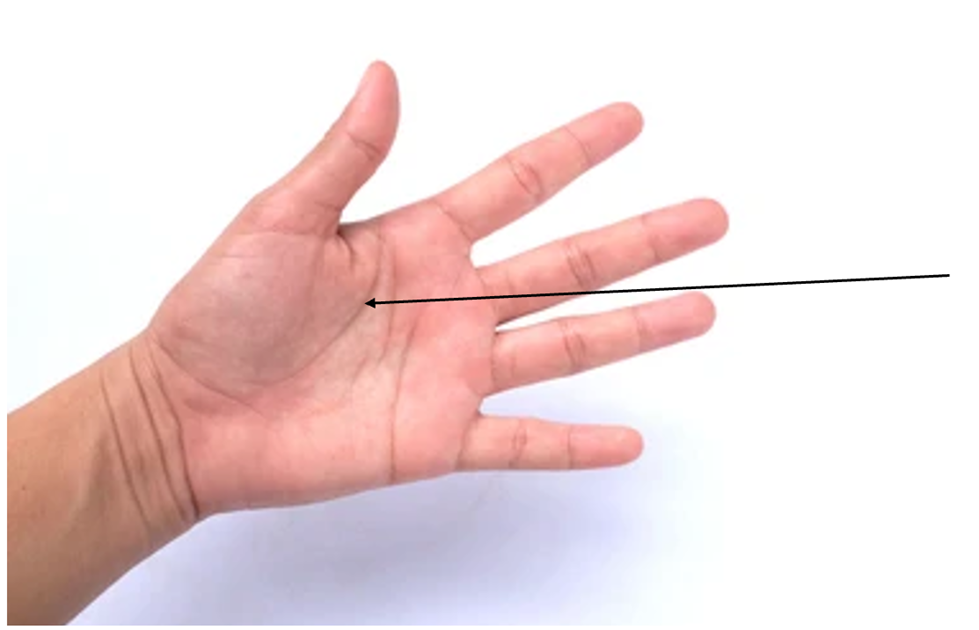
Which structure is highlighted and indicated by the leader line?
Radial artery.
Superficial palmar arch.
Common digital arteries.
Brachial artery.
Ulnar artery.
The Correct Answer is B
Choice A rationale
The radial artery is a major artery in the forearm, running along the thumb side. It is a common site for pulse palpation and arterial blood gas sampling due to its superficial location. However, it typically terminates by contributing to the deep palmar arch, not forming the superficial palmar arch directly.
Choice B rationale
The superficial palmar arch is a vascular arcade formed primarily by the superficial branch of the ulnar artery, with a contribution from the radial artery. This arch is located just beneath the palmar aponeurosis and gives rise to the common digital arteries, supplying blood to the fingers.
Choice C rationale
Common digital arteries originate from the superficial palmar arch and run distally along the metacarpals. They then bifurcate into proper digital arteries, which supply the individual digits. These are branches of the arch, not the arch itself.
Choice D rationale
The brachial artery is a continuation of the axillary artery and is the main arterial supply to the arm. It typically bifurcates into the radial and ulnar arteries in the cubital fossa, well before reaching the hand to form palmar arches.
Choice E rationale
The ulnar artery is the larger terminal branch of the brachial artery, descending along the medial side of the forearm. Its superficial branch is the primary contributor to the superficial palmar arch, making it a key vessel in the hand's vascular supply.
Nursing Test Bank
Naxlex Comprehensive Predictor Exams
Related Questions
Correct Answer is A
Explanation
Choice A rationale
Increased viscosity directly impedes blood flow. Viscosity refers to the "thickness" or internal friction of a fluid. Higher viscosity, often due to increased hematocrit or plasma protein concentration, increases resistance to flow, requiring greater pressure to maintain the same flow rate, thus reducing velocity according to Poiseuille's Law.
Choice B rationale
Increased blood pressure provides a greater driving force for blood flow. According to Ohm's Law for fluid flow, flow rate is directly proportional to the pressure gradient. Therefore, a higher pressure propels blood through vessels more quickly, leading to an increased velocity of blood flow, assuming resistance remains constant.
Choice C rationale
Increased vessel radius significantly decreases resistance to blood flow. Resistance is inversely proportional to the fourth power of the radius (Poiseuille's Law). A larger lumen allows blood to flow with less friction against the vessel walls, thereby increasing the velocity of blood flow for a given pressure gradient.
Choice D rationale
Increased afterload refers to the resistance the ventricles must overcome to eject blood. While increased afterload initially reduces stroke volume, the body often compensates with increased contractility or heart rate. However, a sustained increase in systemic vascular resistance, a major component of afterload, can reduce the overall systemic blood flow velocity by increasing the impedance to ejection.
Choice E rationale
Decreased vasomotion implies reduced changes in vessel diameter, potentially leading to less efficient blood distribution and potentially increased overall peripheral resistance if arterioles remain constricted. Reduced vasomotion might hinder the body's ability to adjust blood flow to meet metabolic demands, potentially decreasing localized or overall blood flow velocity.
Correct Answer is B
Explanation
Choice A rationale
During exercise, local accumulation of metabolic byproducts like lactic acid, carbon dioxide, and adenosine in active muscles causes vasodilation, not constriction, of precapillary sphincters and arterioles. This vasodilation increases blood flow to meet the increased metabolic demand.
Choice B rationale
During exercise, the adrenal medulla releases epinephrine and norepinephrine, and sympathetic nerves release norepinephrine. These catecholamines cause widespread vasoconstriction in inactive tissues but induce vasodilation in skeletal muscles through specific receptor activation (beta-2 adrenergic receptors), increasing blood flow to working muscles.
Choice C rationale
Muscle contraction does compress blood vessels, aiding venous return (skeletal muscle pump). However, this is a mechanical action aiding circulation, not the direct effect of adrenal medulla and sympathetic nerves on arteriolar diameter in response to exercise, which primarily involves neurochemical regulation.
Choice D rationale
During exercise, the sympathetic nervous system is highly activated, leading to a "fight or flight" response. Conversely, the parasympathetic nervous system, which promotes "rest and digest" functions, is generally inhibited or its activity is decreased, not activated, to allow for increased cardiac output and blood flow to muscles.
Whether you are a student looking to ace your exams or a practicing nurse seeking to enhance your expertise , our nursing education contents will empower you with the confidence and competence to make a difference in the lives of patients and become a respected leader in the healthcare field.
Visit Naxlex, invest in your future and unlock endless possibilities with our unparalleled nursing education contents today
Report Wrong Answer on the Current Question
Do you disagree with the answer? If yes, what is your expected answer? Explain.
Kindly be descriptive with the issue you are facing.
